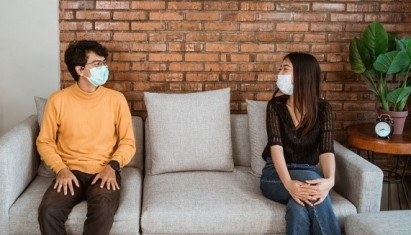Patient Care In the Era of COVID-19 and Beyond
Posted on July 20, 2020 |
This article was written by Mike Hess, MPH, RRT, RPFT

There’s a lot of talk about how SARS-CoV-2, commonly known as the coronavirus, has changed our world. There are certainly things that are significantly different these days; social distancing stickers dot waiting room floors, “contactless” deliveries have become normalized, there’s a lot more Plexiglass around. We have become much more aware of people around us coughing and sneezing. We’ve started weighing the risks and benefits of participating in activities we once did without a second thought, from going to the movies to seeing friends at a restaurant to getting our hair trimmed. For many of us in health care, the pandemic has, in fact, had a profound influence on our daily routines and rituals.
The same is not necessarily true for our patients, though. Not because they haven’t had to change their day-to-day, but because they were already there.
That point was driven home to me fairly early in the pandemic. For several years now, I have participated in a variety of COPD-centric online and social media groups, from COPD360social to my own group on Facebook, COPD Navigator. I have been fortunate enough to develop connections with people living with COPD, their caregivers, and clinicians across the country. These connections give us the opportunity to see a vast number of different viewpoints and opinions, but the pandemic illustrated something of an anomaly: While many of us were taking to our feeds to talk about how things had changed for us overnight, most of the COPD community was essentially going about their business. They were already distancing. They were already consolidating trips to reduce exposures. They were already washing their hands, and usually already even wearing masks, at least at high-risk contact points. They were already taking all the “new” steps being suggested to protect themselves.
That was eye-opening for me, and it was subsequently borne out by a couple of early studies that pointed out that the COPD population was statistically under-represented in the COVID19 cohort (meaning those steps were actually working). Think about that for a moment. Every concern or fear you’ve had during the pandemic? That’s life with COPD, as reported by the people walking the path. Conflicting, unclear information? All the time with COPD. Constant worry about who around you might get you sick? Routine with COPD. Unpredictable stress and fatigue? Ever-present. Anxiety and depression from being isolated from friends and family? Absolutely. On top of that, the relatively few places people were interacting (like pulmonary rehab facilities and support groups) were suddenly inaccessible. It is therefore essential for us on the clinical side of the stethoscope to not only find ways to fill these new gaps, but to realize that they also represent opportunities for us to build better systems for the future. Notice that I didn’t say “fill in until we get back to normal,” because our old normal didn’t really work for many people with COPD, and I firmly believe we can do better. But while we’re working on implementing that, there are some things we can do right now to make sure the people in our care are supported and safe.

- See people where they are. During the crisis, CMS waived many regulations connected to telehealth and remote care delivery. This has been a boon to many who have transportation barriers, logistical barriers (like certain health conditions that demand the use of portable oxygen sources), or even infection control barriers, who can now receive much of their care from the safety of their homes. While it’s true that a telehealth visit may not provide every data point an in-person one can (and it’s also true that not everyone is comfortable with telehealth or has consistent, affordable internet access), consider how much of your therapy guidance can be informed simply by looking at someone. Having done tobacco cessation counseling, demonstrations of inhaler technique, completing symptom surveys, and evaluating action plans all myself online, these all readily translate. Plus, video can offer insight into someone’s actual living environment that they wouldn’t necessarily volunteer in the office, and when people are more comfortable, they’re more likely to feel supported and stay positive. It’s a perfect time to innovate, for those people who are willing and able to participate.
- Clear up misinformation. Masks are having a moment right now, but they are also something of a hot potato topic in many circles. By building on the trust you have already developed, you can debunk some of the myths and misconceptions about masks. Perhaps most importantly, you can help your patients select the mask that best fits their needs. Constantly changing medication information has also led to a variety of reactions regarding things like inhaled corticosteroids; your patients are depending on you to proactively guide them through the confusion. Remember that “telehealth” isn’t just about formal visits, either; this is where non-clinical applications like the now-ubiquitous Zoom conference come into play, and allow unique educational experiences. Online conference software allows clinicians the ability to safely host events from support groups to harmonica sessions to informal pulmonary rehab sessions; while on lockdown, I held a weekly “Fitness Friday” episode on my channel that highlighted activities such as chair yoga & active video games that can be adapted to a variety of endurance levels.
- Self-care and reflection are critical.
 This is a largely unprecedented situation, with rapidly changing variables and no clear end in sight. That affects everyone a little differently, even those who may already be living pandemic-like lifestyles. Remember that it’s OK to not be OK and to take time out to ground and re-center yourself. It’s the same logic as when the flight attendant tells you to put your own oxygen mask on first: you can’t effectively care for others if you have nothing left to give. I have also seen benefit from that eye-opening realization that this is how many already live. It’s something you can realize intellectually and still not fully understand, but now we’re all living it. However, however far away the end might be, it will end for those of us without the daily concerns of chronic conditions. Feel these moments, remember them, and have them guide your interactions with people for whom this truly is a way of life.
This is a largely unprecedented situation, with rapidly changing variables and no clear end in sight. That affects everyone a little differently, even those who may already be living pandemic-like lifestyles. Remember that it’s OK to not be OK and to take time out to ground and re-center yourself. It’s the same logic as when the flight attendant tells you to put your own oxygen mask on first: you can’t effectively care for others if you have nothing left to give. I have also seen benefit from that eye-opening realization that this is how many already live. It’s something you can realize intellectually and still not fully understand, but now we’re all living it. However, however far away the end might be, it will end for those of us without the daily concerns of chronic conditions. Feel these moments, remember them, and have them guide your interactions with people for whom this truly is a way of life.
Certainly, there is a lot of darkness in the world right now. By being a beacon for those in our care, we can help shine some light for many, and perhaps even illuminate a path for ourselves. Take time to be someone’s light today!